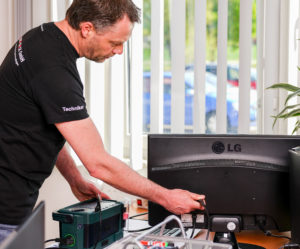DGUV-A3: Ensuring Safety and Compliance in the Workplace
In today’s fast-paced industrial landscape, ensuring the safety and well-being of employees is paramount. Companies need to adhere to stringent regulations to maintain a secure work environment. One such vital regulation that every German workplace must comply with is DGUV-A3. In this article, we will delve into the intricacies of DGUV-A3, understanding its significance, and exploring how businesses can stay compliant while prioritizing the safety of their workforce.
Understanding DGUV-A3: What Does it Stand For?
DGUV-A3 stands for „Deutsche Gesetzliche Unfallversicherung – Arbeitsmedizinische und Sicherheitstechnische Betreuung“ in German, which translates to „German Social Accident Insurance – Occupational Medical and Safety Technical Support“ in English. This regulation outlines the responsibilities of employers concerning the safety and health protection of their employees, especially regarding electrical equipment and installations.
Importance of DGUV-A3 Compliance
Ensuring compliance with DGUV-A3 is crucial for several reasons. First and foremost, it guarantees the safety of employees by reducing the risk of accidents related to electrical installations. Compliance also protects businesses from legal repercussions, fines, and damage to their reputation. Furthermore, it fosters a positive work environment, enhancing employee morale and productivity.

Steps to Achieve DGUV-A3 Compliance
Achieving DGUV-A3 compliance requires a systematic approach and a thorough understanding of the regulation’s requirements. Here are the essential steps businesses need to take:
1. Risk Assessment
Conduct a comprehensive risk assessment of all electrical equipment and installations within the workplace.
2. Regular Inspections
Schedule regular inspections of electrical systems to identify potential hazards and rectify them promptly.
3. Employee Training
Provide employees with proper training regarding the safe use of electrical equipment and how to respond in case of emergencies.
4. Documentation and Record-Keeping
Maintain detailed records of inspections, training sessions, and any corrective actions taken to demonstrate compliance.
5. Engage Qualified Personnel
Employ qualified electrical experts to design, install, and maintain electrical systems, ensuring they meet the required standards.
6. Emergency Response Plan
Develop a comprehensive emergency response plan outlining procedures to be followed in the event of electrical accidents or failures.
Verständnis von DGUV-A3: Was bedeutet das?
DGUV-A3 steht für „Deutsche Gesetzliche Unfallversicherung – Arbeitsmedizinische und Sicherheitstechnische Betreuung. Diese Verordnung legt die Verantwortlichkeiten der Arbeitgeber in Bezug auf die Sicherheit und den Gesundheitsschutz ihrer Mitarbeiter fest, insbesondere im Zusammenhang mit elektrischen Anlagen und Installationen.
Bedeutung der DGUV-A3 Einhaltung
Die Einhaltung von DGUV-A3 ist aus mehreren Gründen von entscheidender Bedeutung. Erstens garantiert sie die Sicherheit der Mitarbeiter, indem sie das Risiko von Unfällen im Zusammenhang mit elektrischen Installationen reduziert. Die Einhaltung schützt Unternehmen auch vor rechtlichen Konsequenzen, Geldstrafen und Rufschäden. Darüber hinaus fördert sie ein positives Arbeitsumfeld und steigert die Mitarbeitermorale und -produktivität.
Schritte zur Erreichung der DGUV-A3 Einhaltung
Die Einhaltung von DGUV-A3 erfordert einen systematischen Ansatz und ein gründliches Verständnis der Anforderungen der Verordnung. Hier sind die wesentlichen Schritte, die Unternehmen unternehmen müssen:
1. Risikobewertung
Führen Sie eine umfassende Risikobewertung aller elektrischen Geräte und Installationen am Arbeitsplatz durch.
2. Regelmäßige Inspektionen
Planen Sie regelmäßige Inspektionen der elektrischen Systeme, um potenzielle Gefahren zu identifizieren und diese umgehend zu beheben.
3. Mitarbeiterschulung
Bieten Sie den Mitarbeitern eine angemessene Schulung zur sicheren Verwendung von elektrischen Geräten und zum Verhalten im Notfall.
4. Dokumentation und Aufzeichnunge
Führen Sie detaillierte Aufzeichnungen von Inspektionen, Schulungssitzungen und allen ergriffenen Korrekturmaßnahmen, um die Einhaltung nachzuweisen.
5. Qualifiziertes Personal einsetzen
Beschäftigen Sie qualifizierte Elektroexperten, um elektrische Systeme zu entwerfen, zu installieren und zu warten und sicherzustellen, dass sie den erforderlichen Standards entsprechen.
6. Notfallpläne
Entwickeln Sie einen umfassenden Notfallplan, der Verfahren zur Befolgung im Falle von elektrischen Unfällen oder Ausfällen beschreibt.
Schlussfolgerung
Zusammenfassend ist die Einhaltung von DGUV-A3 nicht nur eine gesetzliche Anforderung; sie ist ein Engagement für die Sicherheit und das Wohlbefinden der Mitarbeiter. Durch die Einhaltung dieser Verordnung können Unternehmen eine sichere Arbeitsumgebung schaffen, Risiken minimieren und die Gesamtproduktivität verbessern. Die Umsetzung von DGUV-A3 ist ein proaktiver Schritt zu einem sichereren Arbeitsplatz und einer erfolgreichen Zukunft für Arbeitgeber und Mitarbeiter.
FAQs (Frequently Asked Questions)
Q1: What are the penalties for non-compliance with DGUV-A3? Non-compliance with DGUV-A3 can result in significant fines and legal consequences for businesses. It can also lead to workplace accidents, affecting employees‘ well-being.
Q2: How often should electrical inspections be conducted to maintain DGUV-A3 compliance? Electrical inspections should be conducted regularly, with the frequency depending on the type of equipment and the level of risk associated with its use. Regular checks, at least annually, are recommended.
Q3: Is DGUV-A3 applicable to all types of businesses in Germany? Yes, DGUV-A3 applies to all businesses in Germany, regardless of their size or industry. Every workplace with electrical installations must comply with this regulation.
Q4: Can businesses conduct DGUV-A3 compliance assessments internally, or do they need external assistance? While internal assessments can be done, it is advisable to seek external assistance from qualified electrical experts or consultants to ensure a comprehensive and accurate evaluation of compliance.
Q5: Where can businesses find resources and guidelines for DGUV-A3 compliance? Businesses can find resources and guidelines for DGUV-A3 compliance on the official website of Deutsche Gesetzliche Unfallversicherung (DGUV) and through certified occupational safety and health professionals.